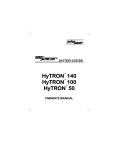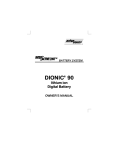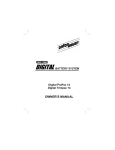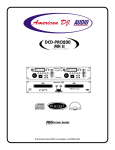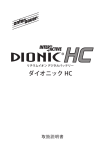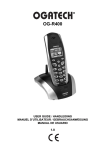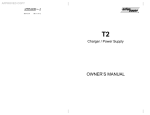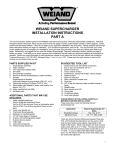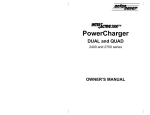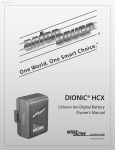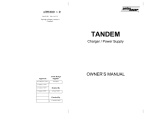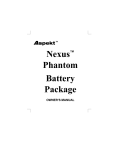Download Anton/Bauer TITAN T2 Owner`s manual
Transcript
APPROVED COPY A7595-0242 Rev G DA-3410, 3308, 3350, B155 & B121 1 of 24 ® BATTERY SYSTEM DIONIC® 160 lithium ion Digital Battery OWNER’S MANUAL Sht APPROVED COPY A7595-0242 Rev G DA-3410, 3308, 3350, B155 & B121 Sht 2 of 24 TABLE OF CONTENTS IMPORTANT READ AND UNDERSTAND THIS MANUAL BEFORE OPERATION……………………………………………-1INTRODUCTION…………………………………………………..-2FEATURES…………………………………………………………-3® CHARGING DIONIC BATTERIES……………………………...-4® RealTime Display Indications……..………….…. ……………-5OVERCURRENT INDICATION………………………………......-9OPERATING GUIDELINES………………………….………….-10SERVICE……………………………………………………… ….-12PRECAUTIONS………………………………………….…… ….-13DIONIC BATTERY SPECIFICATIONS………………………...-14WARRANTY – InterActive 2000™ DIONIC Battery……..… ...-15TRANSPORTATION NOTICE:………………… ……..…..……-16- APPROVED COPY A7595-0242 Rev G DA-3410, 3308, 3350, B155 & B121 Sht 3 of 24 IMPORTANT READ AND UNDERSTAND THIS MANUAL BEFORE OPERATION Please refer to Transportation Notice Section, page 16 prior to shipping or transporting the Dionic 160 on any aircraft. The InterActive Dionic battery’s lithium ion chemistry delivers a higher, power to weight ratio than NiCd & NiMH. However, all lithium ion batteries have more sensitive charging and discharging parameters and require longer charge times (2-4 hours). See charging section page 5 for more details. The Dionic battery will ONLY charge on one of the following chargers: ! Any InterActive 2000 PowerCharger® (software rev 3.6 or higher) ! Titan™ T2, Titan TWQ, and Titan Twin ! Titan 70 (models with S# 1032 and lower may need to be upgraded at factory) THE DIONIC BATTERY CANNOT BE CHARGED ON Anton/Bauer" PowerCharger XM2004 OR XM2002 charge modules. DO NOT attempt to charge on any charger that is not listed above. Special safety circuits in the DIONIC battery will prevent charging on ANY charger, which cannot properly address the battery communication. This DIONIC battery, because of its lithium ion chemistry, is unlike other video batteries you may have used. Special precautions and handling instructions are contained in this manual and should be strictly adhered to for safe and reliable operation. Contact Anton/Bauer Customer Support at (203) 925-4991 with any questions regarding this product. 1 APPROVED COPY A7595-0242 Rev G DA-3410, 3308, 3350, B155 & B121 Sht 4 of 24 INTRODUCTION The development of this new DIONIC 160 battery system has been made possible through the incorporation of the pioneering InterActive® technology of the Anton/Bauer Digital system with the very latest lithium ion cell formulations. The new DIONIC 160 employs a lithium ion cell, exclusive to Anton/Bauer, specifically designed for high current military applications. As a result the DIONIC 160 has the capacity and performance characteristics formerly reserved to nickel based chemistries – current carrying capabilities of up to 10 amps (125 watts), capacity double that of most other lithium ion batteries, no on camera lighting restrictions – all at a weight of only 3.4 pounds (1.5kg.). Each DIONIC 160 battery features an on-board “fuel computer” to monitor energy put into and taken out of the battery, as well as critical operating characteristics and conditions. This data is communicated to the InterActive charger to optimize safe and reliable performance. In addition, remaining battery capacity information is available to the operator by means of a RealTime LCD display on each battery and in the viewfinder of the most popular broadcast and professional camcorders. The patented interface from the Digital battery to the camera viewfinder is factory standard equipment on most camera/camcorder models from the leading camera manufacturers. Anton/Bauer InterActive 2000 chargers were designed in anticipation of new cell technologies, so chargers in the field require only a single chip update to effectively address this new battery system, as well as the standard ProPac", HyTron#, ProFormer" and TrimPac" battery products. This upward and downward compatibility uniquely allows Anton/Bauer to introduce new high performance cell technologies, such as DIONIC, safely and seamlessly into existing battery inventories. 2 APPROVED COPY A7595-0242 Rev G DA-3410, 3308, 3350, B155 & B121 Sht 5 of 24 The new DIONIC 160 battery will automatically identify itself to the InterActive 2000 charger or Titan Series, activating the specialized charge routines necessary to effectively utilize this new technology. FEATURES 1. Microprocessor Fuel Computer - Accurately monitors the energy in the battery with programs that take into account battery age, self discharge, charge/discharge rate, operating conditions and previously experienced charge/discharge cycles. The DIONIC battery constantly “learns” its precise state of charge and remaining capacity. This data is automatically transmitted to an InterActive charger. 2. Integral RealTime ‘LCD’ – This new and exclusive Anton/Bauer feature displays both the remaining runtime and the percentage of remaining battery capacity at all times - simultaneously. No special adapters or set up is required. (see complete explanation page 7-8) 3. Viewfinder Fuel Gauge Display - Cameras which include the Anton/Bauer InterActive viewfinder feature connect with the DIONIC battery “Fuel Computer” to display an accurate “Fuel Gauge” of remaining battery capacity in the viewfinder. Reference your camera/camcorders owner’s manual for proper menu settings. 4. Impac® Case design - High impact case construction protects the cells from impact that would damage or destroy conventional batteries. 5. Gold Mount® Interface - Patented worldwide standard Gold Mount connector is compatible with all Anton/Bauer camera mounts and accessories. 6. Individual Computer Testing – As with all Anton/Bauer batteries, each and every InterActive 2000 DIONIC battery is individually tested to assure optimum capacity, voltage and overall quality. A serialized computer performance graph as confirmation of this testing is enclosed. 3 APPROVED COPY A7595-0242 Rev G DA-3410, 3308, 3350, B155 & B121 Sht 6 of 24 CHARGING DIONIC BATTERIES • DO NOT ATTEMPT TO CHARGE THIS BATTERY WITH ANY CHARGER OTHER THAN THE ANTON/BAUER InterActive CHARGERS SPECIFIED IN THIS MANUAL. •Allow the battery to reach a steady green (LifeSaver®) mode before using for the first time. Please read the individual charger Owner’s Manual to become acquainted with the many unique operating features of the chargers. • The DIONIC battery will be approximately 90% charged when the LED’s on the charger indicate FLASHING GREEN. The battery is 100% charged when the charger indicates STEADY GREEN. The Dionic battery may be removed from the charger and discharged in either condition. •The Dionic battery can remain on the charger until just prior to being used. The LifeSaver (STEADY GREEN charger LED indication) maintenance routine keeps the battery charged and ready for use. If the battery will not be used for an extended period (more than 60 days) see “Operating Guidelines” on page 11. For best results this battery should be used or returned to the InterActive charger within 48 hours of being removed from the charger. 4 APPROVED COPY A7595-0242 Rev G DA-3410, 3308, 3350, B155 & B121 Sht 7 of 24 The DIONIC features an all NEW “RealTime” LCD display providing on-the-fly remaining run time estimates in 15 minute increments as well as simultaneously providing remaining capacity information using the traditional “Fuel Gauge” approach. No special adapters or set up is required. RealTime automatically calculates the load and displays capacity information and battery status at all times. Special electronics protect the lithium ion cells in the DIONIC battery from damage and to ensure safe operation. These electronics work in conjunction with the Digital Battery electronics and will give the operator additional indications in the RealTime display of the battery’s status as outlined below. Remaining Runtime Hours Minutes Side Bars Fuel Gauge Bars “Service” Segment “RES” Bar “InterActive” Segment 5 APPROVED COPY A7595-0242 Rev G DA-3410, 3308, 3350, B155 & B121 Sht 8 of 24 -The large numbers 1, 2 or 3 indicate remaining hours under current load (only one number will display at any one time) -The pie chart numbers (15, 30, 45, or 60) indicate remaining minutes under current load. -The InterActive Segment indicates a FULLY CHARGED battery verified by charger communication -Top BAR: Indicates 75%-96% - 2nd BAR: Indicates 50% - 75% - 3Rd BAR: Indicates 25% - 50% - 4th BAR: Indicates 7% - 25% - INTERACTIVE 96 - 100% -RES BAR: Indicates 0 - 6% 1. 2. 3. 4. “INTERACTIVE” SEGMENT: When illuminated, it indicates the DIONIC battery has completed its full charge routine. “RES” Bar: Is the last “Fuel Gauge” Bar and will start to flash at 6% capacity and will continue to flash until EOD is reached. “SERVICE” SEGMENT: Indicates self-diagnostic functions have detected anomalies. A battery with a “Service” flag should be returned to the Anton/Bauer Service Department. “SIDE BAR” SEGMENTS: Will remain ON (see below). 6 APPROVED COPY A7595-0242 Rev G DA-3410, 3308, 3350, B155 & B121 Sht 9 of 24 If the SIDE BARS (only) flash, this indicates the battery has requested to be fully charged and discharged in order to update its “learned capacity”. This “learning” should typically occur during normal equipment operation. However, if the battery has not been fully charged and discharged for some time, this indication will appear. To remove the flashing SIDE BARS, fully charge the battery (STEADY GREEN indication) on the InterActive 2000 charger. Then either: (a) Discharge the battery on a camera in normal operation continuing to keep the camera “hot” until it shuts down. Then return the battery to the charger. When the battery is full remove it from the charger. (b) This can be done automatically with an InterActive2000 PowerCharger with a DDM (Diagnostic Discharge Module installed. This unique feature is called “AUTOCAL” and is included as standard on QUAD 2702 PowerChargers. (Please reference the appropriate PowerCharger Owner’s Manual.) IMPORTANT NOTE: The flashing SIDE BARS indication is not a warning indication. The battery will operate perfectly normal while awaiting a “learning” cycle. Rather than relying on an “assumed” capacity, as with some imitation fuel gauges, the DIONIC battery relies on the Digital Battery electronics to update capacity information as the battery sees different operating conditions and ages normally. The flashing bars are merely an indication that the battery has not updated this information for some time and is requesting a confirmation of its “learned” capacity. 7 APPROVED COPY A7595-0242 Rev G DA-3410, 3308, 3350, B155 & B121 Sht 10 of 24 RealTime Display Indications ! When the DIONIC battery is being charged no remaining runtime is displayed. ! Remaining run time is calculated using the present available battery capacity and a constantly updated accurate measurement of the present load on the battery. ! If no load is detected, or if the battery is removed from the charger before any discharge load is applied, the default assumed power for remaining run time calculations is 20 Watts. ! When the battery determines that a load is attached, remaining run time will be calculated based on that load and the time remaining will be updated. ! The battery will “learn” this new load and retain that load information in non-volatile memory. If the battery is removed from the camera it will retain this information for 30 minutes or until it is returned to the charger or sees a new load. After 30 minutes the battery will return to the default load of 20 watts. 8 APPROVED COPY A7595-0242 Rev G DA-3410, 3308, 3350, B155 & B121 Sht 11 of 24 OVERCURRENT INDICATION ! If the DIONIC battery is subjected to a load that exceeds specifications, all status icons on the LCD will flash at a once per second rate. This can occur, for example, if a cold halogen light =/>125 watts is turned on. When the over-load condition is removed, the display will return to normal. ! When the battery is completely discharged the LCD will flash the 15 minute icon and the ‘RES’ bar until the battery is returned to a charger. ! If the protection electronics detect a low battery voltage condition the Fuel Gauge will be disabled and the LCD will go blank until the battery is returned to a charger. 9 APPROVED COPY A7595-0242 Rev G DA-3410, 3308, 3350, B155 & B121 Sht 12 of 24 OPERATING GUIDELINES 1. Keep batteries cool or at room temperatures whenever possible. Sustained elevated temperatures are the primary reason for premature failure of lithium ion batteries: a. Charging - Charge batteries at room temperature. In warm climates keep chargers in air conditioned rooms for best performance. b. On assignment - Do not leave batteries in a hot vehicle trunk or exposed to direct sunlight. c. Although lithium ion has good self-discharge characteristics, long term storage in a fully charged condition will result in irreversible capacity loss. This is a problem for all lithium ion batteries – from cell phones to video cameras. Use the battery; do not store it for extended periods. d. Batteries should always be stored in a partially charged state and kept cool. If batteries must be stored for a long period (over six months), they should be periodically removed from storage and submitted to a discharge/charge cycle. 2. Do not over-discharge batteries - It is quite proper to discharge a battery until a low voltage warning in the camera or VTR is observed. However, a switch to a fresh battery should occur as soon as possible following such indication. Never leave a battery operated device unattended while it is running. 3. DO NOT LEAVE A BATTERY ATTACHED TO A CAMERA/CAMCORDER during transit or storage. “Keep warm” circuitry in the camera can drain the battery The DIONIC battery has specialized circuits which will not allow a battery to over discharge, the battery will protect itself and shut down. 10 APPROVED COPY A7595-0242 Rev G DA-3410, 3308, 3350, B155 & B121 Sht 13 of 24 4. Low voltage batteries can also be caused by allowing batteries to remain off the charger for extended periods causing the LCD display to be blank, indicating that the electronic circuitry has removed all load from the battery cells – including the display. In the case that the battery is in a low voltage condition the battery should be returned to the charger. The charge routine will not be initiated by the charger until all other batteries have completed their fast charge routines. Therefore, a low voltage battery can be installed on an InterActive charger without the charger indicating recognition. The battery should remain on the charger until charging is complete. It may be helpful to remove other batteries before placing a battery with a blank display on the charger. 5. Never leave any battery unattended on equipment. 6. Routine use of a battery at discharge rates greater than the battery rating (e.g. 125 watts maximum, <100 watts for lighting load) can reduce overall service life. Always select the proper size battery for your application. 7. Discharging the battery for diagnostic purposes should only be performed on an occasional basis (once every 6-8 weeks at most). Unnecessary discharging only detracts from overall life. 8. Periodic cleaning of both the charger terminals and battery terminals will ensure continued reliable operation. Clean the terminals occasionally with a pencil eraser or lightly scrape the surface with a blunt instrument to help reduce this possibility. Anton/Bauer publishes a comprehensive “Video Battery Handbook” to help you further understand the care and use of video batteries. This guide is available at no charge by contacting Anton/Bauer at 1-800-422-3473 or 203-929-1100 or fax 203-929-9935. It can also be downloaded from the web at www.antonbauer.com. 11 APPROVED COPY A7595-0242 Rev G DA-3410, 3308, 3350, B155 & B121 Sht 14 of 24 SERVICE In the event a DIONIC 160 battery fails to deliver acceptable performance, it must be returned to Anton/Bauer. No other facility is qualified and equipped to service the InterActive DIONIC batteries and calibrate the electronic components and sensors. Any attempt by the user or any other unauthorized persons to service this battery will surely result in improper calibration of the electronic components resulting in severe battery damage and/or safety hazards, including potential personal injury and/or damage to property. Any such attempt will void any/all unconditional warranties. Therefore: 1. NEVER attempt to service this battery. If there is a problem, send this battery only to Anton/Bauer for evaluation. 2. NEVER ATTEMPT TO OPEN THIS BATTERY. The electronic circuits inside the battery can be damaged causing malfunction and/or potential hazard to person and property. 3. NEVER attempt to replace the cells in this battery – it cannot be rebuilt. At the end of its useful life contact the Anton/Bauer Customer Support Group. 12 APPROVED COPY A7595-0242 Rev G DA-3410, 3308, 3350, B155 & B121 Sht 15 of 24 PRECAUTIONS 1. Do not expose this battery to high temperatures (above 50°C/120°F). This includes storage in direct sunlight , in cars in hot weather, or in close proximity to heating devices. This may cause electrolyte leakage, impaired performance and shortening of battery service life. 2. When not using the battery for prolonged periods, the DIONIC battery should be charged to approximately 50% capacity and removed from the charger. Long term storage in the full charge state will result in deterioration of capacity, which is unrecoverable in subsequent use. 3. ALL LITHIUM ION BATTERIES have a finite life. If the battery exhibits noticeably shortened run time the battery should be replaced immediately. Shortened runtime is indicative of at least one cell, which has reached end of life. UNDER NO CIRCUMSTANCES attempt to “recondition” this battery by repeated charging and discharging. 4. This battery contains specialized electronic circuits, which are designed to protect the lithium ion cells from overcharge, over discharge and overcurrent . Redundant protection devices are designed to operate if the battery voltage is abnormally high or low and if the temperature of the battery exceeds operating specifications. These electronic devices can be damaged if the battery is subject to abuse or damage. Do not use a battery that has been subjected to excessive mechanical shock or water damage. 5. Do not drop, puncture or crush this battery. Do not use the battery if the case is damaged or broken. 13 APPROVED COPY A7595-0242 Rev G DA-3410, 3308, 3350, B155 & B121 Sht 16 of 24 DIONIC BATTERY SPECIFICATIONS OUTPUT VOLTAGE 14.4v Nominal 12.4 ~ 16.4v Operating CAPACITY (CELL CAPACITY) 160 WH Nominal (11 AH Rated) FUSE Internal 15amp RECOMMENDED OPERATION 15 - 130 watts (MAXIMUM DISCHARGE RATE) (200 watts)2 TYPICAL RUN-TIME @ 20w - 8 hrs. @ 25w – 6 1/2 hrs. @ 40w – 4 hrs. WEIGHT 3.4 lbs. (1.5kg) SIZE 3.75x4x5 ¼” (9.53x10.16x13.35 cm) OPERATING TEMPERATURE -30° - +50° C 2 1 Routine use of a battery at discharge rates greater than the battery rating (e.g. >125w for DIONIC 160) can reduce overall service life. Always select the proper size battery for your application. 14 APPROVED COPY A7595-0242 Rev G DA-3410, 3308, 3350, B155 & B121 Sht 17 of 24 LIMITED WARRANTY This warranty for the battery product specified in this document is given by Anton/Bauer, Inc. (“Anton/Bauer”), 14 Progress Drive, Shelton, Connecticut 06484. If you have any questions regarding product applications, product specification, or to obtain warranty service on this or any Anton/Bauer product, contact the company at the address above. THIS PRODUCT MUST BE REGISTERED WITH ANTON/BAUER WITHIN 30 DAYS OF PURCHASE TO ASSURE WARRANTY COVERAGE. TO REGISTER YOU MAY EITHER (1) MAIL WARRANTY REGISTRATION CARD or (2) REGISTER ON LINE AT www.antonbauer.com. Warranty registration, including the serial numbers of Anton/Bauer chargers used with this battery, must be supplied to Anton/Bauer. Anton/Bauer will warranty the Product only against defects in material and workmanship for the period as follows from the date of purchase, in accordance with the terms set forth below, and then, only if the Product is used exclusively in conjunction with compatible Anton/Bauer chargers. If this battery is returned to Anton/Bauer for warranty service it will be required that the user provide model names and serial numbers of compatible Anton/Bauer chargers with which this product was used. DIONIC 160 : 0-12 MONTHS: Anton/Bauer will repair or replace the product at Anton/Bauer’s option and cost 13-24 MONTHS: Anton/Bauer will repair the product without charge or replace the product at a cost equaling 1/24 of the list price or purchase price times the number of months from the purchase date or date of manufacture. “Purchase price” and “purchase date” as referenced is the unit price paid by and the date of such sale to the original customer from any authorized Anton/Bauer dealer or distributor and does not include any tax, shipping, VAT, duty, fees or handling charges. Customer must provide proof of purchase or Manufacture’s list price will be used. This warranty shall be effective only if Anton/Bauer receives notice of such defects in materials or workmanship during the period of the warranty. Minimum battery capacity is defined under this warranty as 60% of nominal specified capacity for this product at time of purchase. The liability of Anton/Bauer hereunder is expressly limited to a claim for repair or replacement of the Product or as otherwise stated herein at Anton/Bauer’s sole discretion. Notice of any claim under this warranty shall be delivered to Anton/Bauer during the period of the warranty and the Product should be returned with its packaging promptly, at purchaser’s expense, to an Anton/Bauer Customer Support Center or to the address above. Upon receipt of the Product and a record of your compliance with the conditions of this warranty, Anton/Bauer will repair or replace the Product and return it to you, or issue a credit, as applicable. Customer is responsible for all shipping and handling charges to and from authorized service facility. THIS WARRANTY DOES NOT APPLY TO AND IS VOID IN THE CASE OF DEFECTS OR DAMAGE RESULTING FROM ACCIDENTS, DISASTER, NEGLECT, MISUSE, IMPROPER INSTALLATION, IMPROPER OR UNAUTHORIZED SERVICE OR MAINTENANCE, UNAUTHORIZED REPLACEMENT PARTS OR ATTACHMENTS; OR DYSFUNCTION OR MALFUNCTION OF, OR CAUSED BY, ANY OTHER PRODUCT OR DEVICE. Misuse includes any use of the Product in other than its intended application, including the use of this Product with any charging device or accessory not manufactured by and/or specified by Anton/Bauer. This warranty does not cover, and Anton/Bauer assumes no responsibility for, any equipment or devices used in conjunction with the Product. Use of unauthorized equipment in conjunction with Anton/Bauer products constitutes misuse under our warranties and may limit or void those warranties. Anton/Bauer does not authorize, condone, recommend, or otherwise assume any liability or responsibility resulting from the use of any APPROVED COPY A7595-0242 Rev G DA-3410, 3308, 3350, B155 & B121 Sht 18 of 24 battery, charger, or accessory made by Anton/Bauer manufacture with any battery, charger or accessory not manufactured, produced or sold by Anton/Bauer. Anton/Bauer only authorizes the use of original Anton/Bauer product with this product. Use only original Anton/Bauer equipment with this product. ANTON/BAUER DISCLAIMS ANY LIABILITY FOR CONSEQUENTIAL DAMAGES FOR BREACH OF ANY WRITTEN OR IMPLIED WARRANTY OF THE PRODUCT. UNDER NO CIRCUMSTANCES WILL ANTON/BAUER BE RESPONSIBLE FOR ANY SPECIAL, INCIDENTAL OR CONSEQUENTIAL DAMAGES. This Warranty is to be construed and enforced in accordance with the law of the State of Connecticut, including the provisions of the Uniform Commercial Code as adopted and from time to time amended in the State of Connecticut, and not the Convention for the International Sale of Goods. This choice of Connecticut law is exclusive of any Connecticut law that would require reliance on any law foreign to Connecticut. Should any action of law or in equity be brought by any person under this Warranty, such action shall be brought only in the United States District Court for the District of Connecticut, or in any Superior Court in Fairfield County, Connecticut, USA. Some states do not allow limitations on how long a warranty lasts, so the time period limitation herein may not apply to you. Some states do not allow the exclusion or limitation of incidental or consequential damages, so the above limitation or exclusion may not apply to you. This warranty gives you specific legal rights and you may have other legal rights which may vary from state to state. Use of unauthorized equipment in conjunction with Anton / Bauer products constitutes misuse under our warranties and may limit or void those warranties. Anton / Bauer does not authorize, condone, recommend, or otherwise assume any liability or responsibility resulting from the use of any battery, charger or accessory made by Anton / Bauer manufacture with any battery, charger or accessory not manufactured, produced or sold by Anton / Bauer. Anton / Bauer only authorizes the use of original Anton / Bauer product with this product. Use only original Anton / Bauer equipment with this product. TRANSPORTATION NOTICE IATA (International Air Transport Association) requirements state that if you are carrying lithium ion batteries onto an airplane then they must fall under the specified level for lithium content. The amount of lithium content determines if the battery can be classified as non-hazardous or it has to be classified as a “dangerous goods” defined by IATA. 16 APPROVED COPY A7595-0242 Rev G DA-3410, 3308, 3350, B155 & B121 Sht 19 of 24 Hazardous Substance Standard of the ICAO and IATA Section A45 Lithium cells and lithium batteries are not subject to these instructions if they meet the following requirements: 2) For a liquid metal or lithium alloy battery with liquid cathodes, the aggregate lithium content is not more than 1g, for a lithium metal or lithium alloy battery with solid cathodes, the aggregate lithium content is not more than 2g, and for a lithium ion battery, the aggregate equivalent lithium content is not more than 8g. Use the following formula to determine if your battery is under the restrictions: AH cell X 0.3 = Lithium content Lithium content X # of cells = grams of aggregate lithium content Amp Hour of cells multiplied by point three, this equals your Lithium content. Take the Lithium content and multiply it by the number of cells in the pack, this gives you the aggregate lithium content. 17 APPROVED COPY A7595-0242 Rev G DA-3410, 3308, 3350, B155 & B121 Sht 20 of 24 Dionic 160 5.5 AH per cell 5.5 AH X 0.3 = 1.65 g Lithium Ion content per cell 1.65 g X 8 cells = 13.2 g Lithium Ion content The Dionic 160 has an aggregate lithium equivalent content of more than 8 grams. Therefore falls into the category of “dangerous goods” and is subject to the following treatment: 1. If shipped or checked in as luggage on aircraft, the Dionic 160 must be handled in accordance with the conditions defined by IATA in “class 9 – Miscellaneous Dangerous Substances and Articles.” (See note on next page*) ! Use the original Dionic 160 box and packing material as they constitute a proper shipping container for the Dionic 160 battery as Class 9 miscellaneous hazardous material. ! The labeling on the rear side of the box must be legible as this identifies it as a proper shipping container. 4G/Y1.9/S/03 USA/+AV2100 ! This is in accordance with IATA ( International Air Transport Association ) and ICAO ( International Civil Aviation Organization ). 2. If brought into the aircraft cabin together with video equipment as carry-on baggage, the Dionic 160 may be brought in as spares (Quantity of two) per person. 18 APPROVED COPY A7595-0242 Rev G DA-3410, 3308, 3350, B155 & B121 Sht 21 of 24 *NOTE: Since the application of the IATA regulations varies according to the aviation company, the transport of the Dionic 160 may be disallowed even when the conditions described above are satisfied. Anton/Bauer therefore highly recommends that you consult with the aviation company prior to transporting the battery pack. It should be noted that the conditions described above might be applied by other kinds of transport operators, e.g., ship or trucking companies. In an effort to increase the level of safety associated with the transport of lithium-ion batteries, the Code of Federal Regulations (49CFR Pats 171, 172, 173 and 175) have mandated that all lithium-ion batteries transported domestically and abroad are required to be tested in accordance with the United Nations Manual of Tests and Criteria as of January 1, 2003. These tests are performed to ensure that designs of lithium-ion batteries are sufficiently robust to allow them to be transported safely. In addition to these tests, batteries with higher lithium content are also classified as dangerous goods. This classification results in certain packaging requirements as well as markings and documentation that explain the actions to be taken in the event of an emergency. 19 APPROVED COPY A7595-0242 Rev G DA-3410, 3308, 3350, B155 & B121 Sht 22 of 24 Frequently asked questions regarding transport of lithium-ion rechargeable batteries: 1) To Whom do these regulations apply? a. All those who ship lithium-ion batteries in bulk form or within equipment. All battery manufacturers as well as battery assembly companies, distributors, dealer, retailers, etc. dealing with lithium-ion products are concerned since the one who ships is the one responsible for compliance with the transport regulations. These regulations apply to domestic and international shipments whatever their mode (land, sea or air). 2) Are there different requirements for different lithium-ion rechargeable batteries? a. Yes. Lithium-ion rechargeable batteries whose lithium content exceeds 8 g. per battery must be shipped as a Class 9 miscellaneous hazardous material. Batteries whose lithium content is less than 8 grams are exempt from this requirement. 3) Are there any shipping requirements for batteries with less than 8 gr. of lithium content? a. Yes. Packages that contain more than 12 lithium-ion batteries must have special markings and shipping documents. For this reason, Anton Bauer recommends that each package contain fewer than 10 batteries. 4) What does Class 9 mean? a. Class 9 is one of nine hazardous materials shipping classifications defined by the US Code of Federal Regulations and other transportation regulations. Class 9 defines the specific packaging, marking, labeling and shipping paper requirements for lithium-ion rechargeable batteries. 20 APPROVED COPY A7595-0242 Rev G DA-3410, 3308, 3350, B155 & B121 Sht 23 of 24 5) Are there Anton Bauer lithium-ion batteries that are required to be shipped as Class 9 miscellaneous hazardous material? a. Yes. Dionic 160 contains more than 8 gr. of lithium per battery and therefore is classified as Class 9 miscellaneous hazardous material. Dionic 90 contains less than 8 gr. of lithium per battery and is not considered Class 9 material. 6) Is any special testing of the batteries themselves required? a. Yes. All lithium-ion rechargeable batteries must be tested in accordance with specifications detailed in UN 3090 regardless of their lithium content. All Anton Bauer batteries have been tested and certified as acceptable to these requirements. 7) Are there any limitations for lithium-ion batteries carried onto aircraft? a. Yes. Passengers are allowed an unlimited number of spare batteries whose lithium content per battery is less than 8 gr. (Anton Bauer Dionic 90). Passengers can also carry no more than two lithium ion batteries that contain more than 8 gr. of lithium per battery (Anton Bauer Dionic 160). 8) Where can shipping instructions be found regarding the procedures for shipping Class 9 Miscellaneous Hazardous materials? a. The code of Federal Regulations 49 parts 100 to 185 (49CFR) and the International Air Transport Association (IATA) Dangerous Goods Regulations explain the requirements, documentation and materials needed in order to ship Class 9 products. 21























